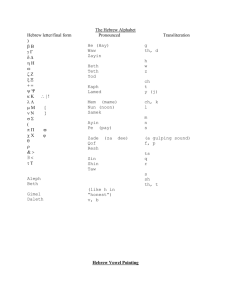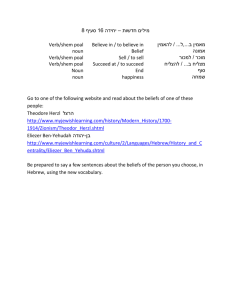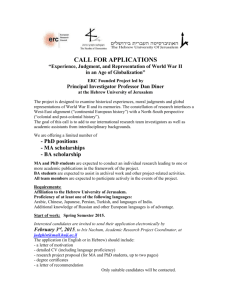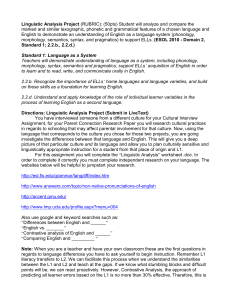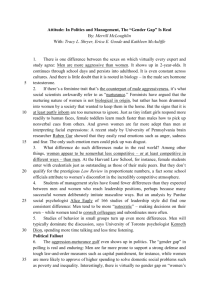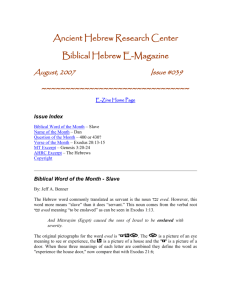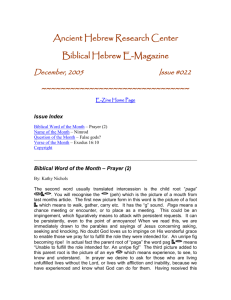Hebrew
advertisement
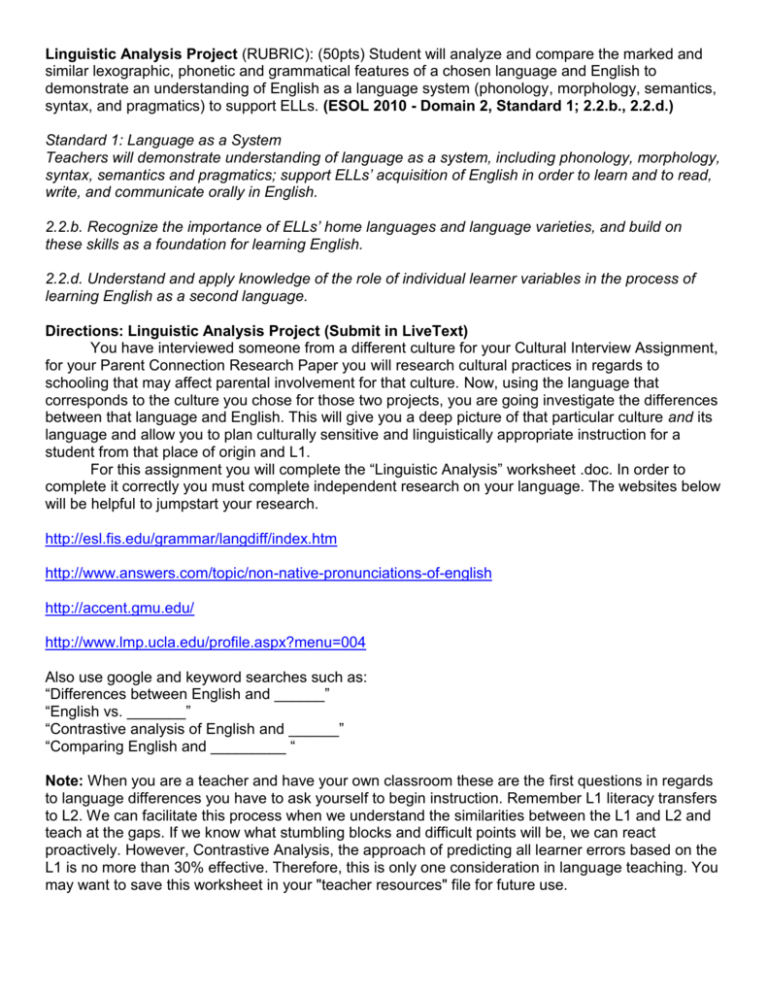
Linguistic Analysis Project (RUBRIC): (50pts) Student will analyze and compare the marked and similar lexographic, phonetic and grammatical features of a chosen language and English to demonstrate an understanding of English as a language system (phonology, morphology, semantics, syntax, and pragmatics) to support ELLs. (ESOL 2010 - Domain 2, Standard 1; 2.2.b., 2.2.d.) Standard 1: Language as a System Teachers will demonstrate understanding of language as a system, including phonology, morphology, syntax, semantics and pragmatics; support ELLs’ acquisition of English in order to learn and to read, write, and communicate orally in English. 2.2.b. Recognize the importance of ELLs’ home languages and language varieties, and build on these skills as a foundation for learning English. 2.2.d. Understand and apply knowledge of the role of individual learner variables in the process of learning English as a second language. Directions: Linguistic Analysis Project (Submit in LiveText) You have interviewed someone from a different culture for your Cultural Interview Assignment, for your Parent Connection Research Paper you will research cultural practices in regards to schooling that may affect parental involvement for that culture. Now, using the language that corresponds to the culture you chose for those two projects, you are going investigate the differences between that language and English. This will give you a deep picture of that particular culture and its language and allow you to plan culturally sensitive and linguistically appropriate instruction for a student from that place of origin and L1. For this assignment you will complete the “Linguistic Analysis” worksheet .doc. In order to complete it correctly you must complete independent research on your language. The websites below will be helpful to jumpstart your research. http://esl.fis.edu/grammar/langdiff/index.htm http://www.answers.com/topic/non-native-pronunciations-of-english http://accent.gmu.edu/ http://www.lmp.ucla.edu/profile.aspx?menu=004 Also use google and keyword searches such as: “Differences between English and ______” “English vs. _______” “Contrastive analysis of English and ______” “Comparing English and _________ “ Note: When you are a teacher and have your own classroom these are the first questions in regards to language differences you have to ask yourself to begin instruction. Remember L1 literacy transfers to L2. We can facilitate this process when we understand the similarities between the L1 and L2 and teach at the gaps. If we know what stumbling blocks and difficult points will be, we can react proactively. However, Contrastive Analysis, the approach of predicting all learner errors based on the L1 is no more than 30% effective. Therefore, this is only one consideration in language teaching. You may want to save this worksheet in your "teacher resources" file for future use. Your Name: Danielle Singleton LINGUISTIC ANALYSIS WORKSHEET (25 questions) Directions: Fill in the blank with the correct answer or highlight/underline the correct choice for each item. 1. Language of Investigation Hebrew 2. What places of origin (countries, regions, cities) is this language primarily spoken? _______Israel________ 3. This closest/ most similar language to this language is____Arabic____ 4. Approximately, how many speakers are there globally of this language? approximately 5.3 million Alphabet: Orthography 5. This language has which type of alphabet? a. Latin (every sign has a single sound) b. Syllabic (every sign represents a whole syllable) c. Logographic (each sign represents and entire word) 6. This language reads in which directions: a. LEFT to RIGHT, UP to DOWN b. RIGHT to LEFT, DOWN to UP c. RIGHT to LEFT, UP to DOWN d. LEFT to RIGHT, DOWN to UP 7. The letters/ characters of this alphabet are of which language family? a. Indo-European e. Uralic b. Sino-Tibetan f. Dravidian c. Semitic g. Austonesian d. Bantu h. Altic 8. Does this language depend primarily on tone or pitch? a. Yes b. No Phonetics and Phonology: 9. What sounds are specific to this language, but are not present in English? , , , , ,a 10. What sounds are found in English, but are not found in this language? , , , dʒ, tʃ, æ, ə, ʊ, ʌ, ɔ, ɪ, ɑ 11. What sounds do speakers of this language have difficulty pronouncing in English? W & V sounds Syntax and Grammar: 12. The word order of this language is a. Verb, subject, object (VSO) d. Verb, object, subject (VOS) b. Subject, verb, object (SVO) e. Subject, object, verb (SOV) c. Object, verb, subject (OVS) f. Lacks a dominant word order 13. Are there particular parts of speech that are represented differently (such as articles or prepositions)? Like English prepositions Hebrew prepositions link nouns, pronouns and phrases to other words. 14. How are tense and aspect indicated? Hebrew verbs do not convey tense. 15. What are the punctuation forms used in this language? List using English comparisons. ״ Gershayim/quotation mark ׳ Geresh/apostrophe ־ Maqaf/hyphen Periods, question marks, commas, and exclamation marks are used as they are in English. 16. How does this language mark gender? Every noun is grammatically masculine or feminine. Morphology: Remember that cognates have the same origin; they are not simply words that sound alike. 17. If there are some shared cognates between English and this language, what are they? If not, why not? _______________Wine, sack, behemoth, camel_______________________ 18. If there are some FALSE cognates between English and this language, what are they? If not, why not? ______________over and ‘avar________________ Semantics: 19. How is formality or respect expressed? 20. What is an informal expression in this language? What is the English translation/meaning? _______________Ma nish ma-How’s it going?_____________________ Pragmatics: 21. What is the common expression for greetings? (In English, we ask “How are you?”) __________Shalom__________________ 22. Are there certain topics that are considered inappropriate or forbidden? __________Not really except when talking to an Orthodox Jew.___________ Teaching Implications: 23. Through your research what have you found are the biggest difficulties of speakers of this language learning English? Please provide specific examples. There are many aspects of Hebrew that are different from English that will make it difficult for a student of this language to learn English. Hebrew reads right to left instead of left to right like we do in English. May struggle with words like then, think and clothes. 24. If you have an early production ELL who this language is their L1, what would be the most important thing you will teach them in regards to the difference between their language and English? The Hebrew alphabet does not contain vowels so they may have difficulty when learning to write in English. They may also need help following the words from left to right and writing from left to right. 25. What would you expect to be ongoing difficulties for intermediate ELLs who this is there L1? What areas would you still need to address even after they had mastered social English? ELL may have problems with grammar. Hebrew sentences usually start with the verb, followed by the subject where English starts with the subject followed by the verb. Hebrew also has no indefinite article so they may make mistakes such as Do you have dog?
